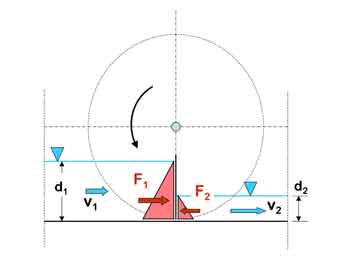HYLOW
Project Description
The project HYLOW has four main project areas:
Converter development
Existing converter technology utilises the potential energy (overshot water wheels), reaction forces (e.g. Kaplan turbines) or the kinetic energy (e.g. Pelton turbines) of the flow. A novel type of energy converter, the Hydrostatic Pressure Converter (HPC) was developed based on theoretical considerations.
The HPC employs the hydrostatic pressure differences between up- and downstream of the machine. This allows for high efficiencies at very low head differences, whilst maintaining river bed continuity. The simplest HPC, the Hydrostatic Pressure Wheel, consists of a wheel with radial blades which act as weir and which move with the velocity of the flow.
 |
| HPW principle |
The hydrostatic force difference F1 - F2 travels with the velocity v1 and generates the power P. The efficiency becomes a funtion of the ratio d2 / d1 . This principle is rather unusual, but experiments have shown good agreement with the theory.
Within the project, the theory of hydrostatic pressure converters will be developed further. Three different power converters for run-of-river, free stream and pipe applications will be developed using model tests. In the area of pipe flow, converters based on reaction as well as hydrostatic pressure principles will be investigated. Finally, Large Scale Models (LSM's) of all three converters will be built to test the technology in natural environments at near prototype scale.
Converter and Environment
Hydropower converters are situated in a natural environment where they can interfere with, or be affected by the natural environment and natural processes.
Biological factors focus on the effects on fish migration (up- and downstream); these will be investigated at model scale during the design of the machines, and at the LSM’s in the field.
Although it is envisaged that the HPC’s will allow sediment to pass through, design solutions have to be found where damage caused by sediment or floating material is minimised. Energy converters constitute focal points for the flow; since currently no converter which allows for bed continuity is known little knowledge exists about sediment intake, deposition or the shape of in- or outflow elements to minimise adverse effects. This issue will be addressed with model tests and field observations.
Finally, the European Water Framework Directive (WFD) constitutes the legal framework for all water bodies and human interference therewith. The compatibility of the novel converters with the WFD will be investigated and it will be tried to establish preliminary guidance for users.
Appropriate technology
Renewable energy is not just a topic for developed countries. In the developing world, there exists both pollution and energy scarcity. Within this project, the newly developed converter technology will be assessed for implementation in developing countries whereby specific emphasis is put onto the demand for the use of local material, local manufacture, island operation and finally local acceptance and ownership. This will hopefully help to employ available potential both in small rivers and in irrigation systems for the urgently needed rural electrification.
Knowledge mining
Even very small sources of mechanical power were very important in the 19th and early 20th Century. Many technologies were developed or suggested; with the development of a carbon based economy however much of this was forgotten. Today, some technologies may – with the use of modern analysis methods and materials – be of interest again. In this activity field, the technical literature in German, English and French will be reviewed to see whether other interesting technologies can be found. An issue of special importance in this field is the analysis of the Eastern European literature on hydropower. This has traditionally been a nearly closed topic in the West due to the combination of political, access and language barreers.
FP7-Energy-2007-1-RTD project number: 212423